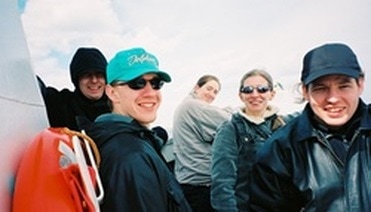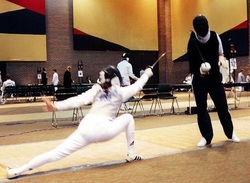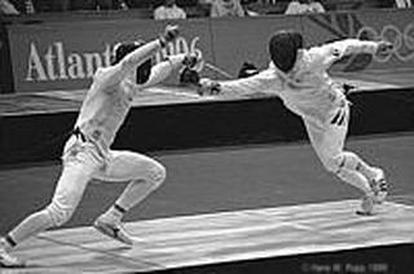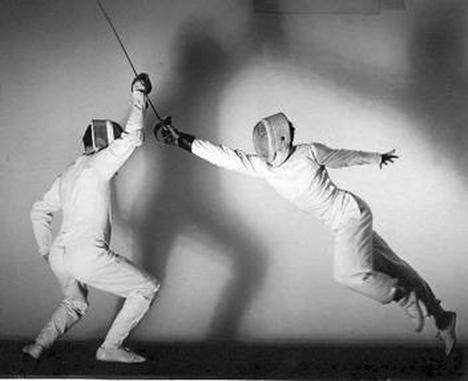'Sport' or 'Olympic' Fencing
My involvement with the University of Sunderland sports clubs began in 1987 (October 17th, if you care). I sort of inherited the club from Robin Catling, who also went to a certain amount of trouble trying to teach me to fence. For various reasons we needed a new coach so in 1989 I (along with three other people) took a Club Leader’s award. The the following year I qualified as a Club Coach. This is the equivalent of the current British Fencing Level 2.
Getting my certificate was something of an epic. After a number of false starts including repeated new Club Leader certificates, in 2007 they finally got around to giving me a proper certificate! By this time the entire coaching system had been revised, so I think I’m listed as a Level 2 coach qualified in 2007. Actually I’m a Club Coach qualified in 1990 and ratified as a Level 2 coach in 2007, but I’ve decided to be happy with what I can get.
It's academic now; I've gone over to the dark side (historical fencing) and I'm not coming back.
Ironically perhaps, I retired from teaching sport fencing in 2008, largely due to politics within the university and the general difficulty of running a class there. However, the club was an important part of my life for many years. A lot of people passed through and many of them I've forgotten. Some left a lasting memory, some are still in touch… and some pretty much make up my circle of close friends.
Getting my certificate was something of an epic. After a number of false starts including repeated new Club Leader certificates, in 2007 they finally got around to giving me a proper certificate! By this time the entire coaching system had been revised, so I think I’m listed as a Level 2 coach qualified in 2007. Actually I’m a Club Coach qualified in 1990 and ratified as a Level 2 coach in 2007, but I’ve decided to be happy with what I can get.
It's academic now; I've gone over to the dark side (historical fencing) and I'm not coming back.
Ironically perhaps, I retired from teaching sport fencing in 2008, largely due to politics within the university and the general difficulty of running a class there. However, the club was an important part of my life for many years. A lot of people passed through and many of them I've forgotten. Some left a lasting memory, some are still in touch… and some pretty much make up my circle of close friends.

Some time later, maybe 2004 or so, on a boat headed for the Farne Islands to antagonize the seals or something.
We also fenced from time to time.
We also fenced from time to time.
The fencing club was one of the oldest at the university. I recently heard from one of the founders, who told me they set up the class in 1957. I joined in 1987, took over as coach in 1989, and ran the class until 2008. It folded largely due to apathy on the part of the University Institute of Sport, who assured me that efforts towards a relaunch would be made and that I’d be involved. Then they relaunched the class with a different coach and didn’t tell me. That venture lasted less than a year (for much the same reasons as the initial fold) and the class once again became moribund. There have been some signs of life in recent months, and we may eventually resurrect the university group in its own right.
But anyway....
We taught modern ‘Sport’ fencing at the club, though with a healthy respect for the historical origins the art – these were once deadly weapons and I tend to view fencing as a martial art rather than a sport.
Modern "Olympic" fencing uses three weapons: the Foil, Epee and Sabre. Some fencers specialize with one weapon and fence the others only for an occasional diversion – or not at all. Most fence Foil as their main weapon and either Epee or Sabre as a secondary interest, some specialise in either Sabre or Epee, and some try to be all-rounders. Which approach is chosen really depends upon the individual and the available clubs or coaches. As a rule though, if you want to be good, you pick one weapon as your main interest and really work at it. The three are sufficiently different that training in more than one weapon represents a significant dilution of effort, though some useful perspective can be gained from cross-training between Foil and Epee or Foil and Sabre.
The Foil: A light, point-only weapon descended from the Smallsword or Court Sword. Foil fencing is where almost everyone starts, and they rapidly discover that a foil is only "light" until you try to take an hour-long lesson with one! Foil fencing tends to be very fast and uses a system of priority rules to determine who is awarded a point if both fencers land a hit. Valid points are only given for a hit on the torso. Hits elsewhere are "off-target".
But anyway....
We taught modern ‘Sport’ fencing at the club, though with a healthy respect for the historical origins the art – these were once deadly weapons and I tend to view fencing as a martial art rather than a sport.
Modern "Olympic" fencing uses three weapons: the Foil, Epee and Sabre. Some fencers specialize with one weapon and fence the others only for an occasional diversion – or not at all. Most fence Foil as their main weapon and either Epee or Sabre as a secondary interest, some specialise in either Sabre or Epee, and some try to be all-rounders. Which approach is chosen really depends upon the individual and the available clubs or coaches. As a rule though, if you want to be good, you pick one weapon as your main interest and really work at it. The three are sufficiently different that training in more than one weapon represents a significant dilution of effort, though some useful perspective can be gained from cross-training between Foil and Epee or Foil and Sabre.
The Foil: A light, point-only weapon descended from the Smallsword or Court Sword. Foil fencing is where almost everyone starts, and they rapidly discover that a foil is only "light" until you try to take an hour-long lesson with one! Foil fencing tends to be very fast and uses a system of priority rules to determine who is awarded a point if both fencers land a hit. Valid points are only given for a hit on the torso. Hits elsewhere are "off-target".

Left: An image borrowed from Fencingsucks.com, demonstrating an alarmingly deep lunge with a rolled ankle. The back foot should be kept flat.
Fencingsucks.com has a large collection of fencing images and generally pokes fun at the sport.
Fencingsucks.com has a large collection of fencing images and generally pokes fun at the sport.
In the event of an off-target hit, the bout is halted and the fencers moved apart before beginning again, but no point is scored. This is because in Smallsword fights, people would often be stabbed repeatedly rather than disabled by a single blow. A Smallsword wound might well not "stop" an assailant, though he would often bleed to death later or die from infection. Hits are only counted if made with the point; flat hits would not injure an opponent in a real duel, though done hard enough they can cause a good deal of irritation!
The other two weapons (Epee and Sabre) are sometimes referred to as "Advanced" weapons. This is not accurate, since although most beginners start with the Foil, it is possible to take up fencing from scratch with any of the weapons, and any or all of them can be taken to a high ("advanced"!) standard. Some fencers consider foil to be the ‘hardest’ weapon since the target area is small and attacks must be deep to avoid falling short.
The Epee: The Epee is a direct descendant of the straight duelling sword. Similar to but heavier than the Foil, the Epee can only score with a thrust but a hit anywhere on the body (even the little toe!) is counted as a hit. This is because the Epee (or any other heavy thrusting sword) has some measure of "stopping power" – a live blade would be capable of inflicting considerable tissue damage, breaking bones rather than skidding off them, and generally spoiling your whole day.
There is no priority system in Epee: the first hit that lands is counted, and double-hits are possible. Epee is about as close to real duelling as you can get in a sport fencing class. (If you want more reality, come on over to the Dark Side like I did, and take up historical fencing). Fights are often technical and subtle, since the relatively heavy weapon does not forgive mistakes that place you out of position.
The other two weapons (Epee and Sabre) are sometimes referred to as "Advanced" weapons. This is not accurate, since although most beginners start with the Foil, it is possible to take up fencing from scratch with any of the weapons, and any or all of them can be taken to a high ("advanced"!) standard. Some fencers consider foil to be the ‘hardest’ weapon since the target area is small and attacks must be deep to avoid falling short.
The Epee: The Epee is a direct descendant of the straight duelling sword. Similar to but heavier than the Foil, the Epee can only score with a thrust but a hit anywhere on the body (even the little toe!) is counted as a hit. This is because the Epee (or any other heavy thrusting sword) has some measure of "stopping power" – a live blade would be capable of inflicting considerable tissue damage, breaking bones rather than skidding off them, and generally spoiling your whole day.
There is no priority system in Epee: the first hit that lands is counted, and double-hits are possible. Epee is about as close to real duelling as you can get in a sport fencing class. (If you want more reality, come on over to the Dark Side like I did, and take up historical fencing). Fights are often technical and subtle, since the relatively heavy weapon does not forgive mistakes that place you out of position.

Another fencingsucks.com image, this time from the 1996 Atlanta Olympics. The fencer at right is launching a fleche (running) attack. The guy at left looks like he’s intending something similar but has been beaten to it.
Rushing in like this is a bit all-or-nothing. Either you score or you get hit. Well-timed it’s devastating. Bad timing turns it into a sort of assisted suicide.
Rushing in like this is a bit all-or-nothing. Either you score or you get hit. Well-timed it’s devastating. Bad timing turns it into a sort of assisted suicide.
Epees are stiff. Where a Foil flexes readily upon a hard hit, with an Epee it is generally the target that does any bending. Epee is thus the most hazardous of the fencing weapons, though all of them are carefully designed to be very safe. Three people died in fencing accidents during the 20th Century, all of them at the Epee. On balance, that's a pretty good safety record.
The Sabre: The Sabre is a light cut-and thrust weapon based on the cavalry sword. Sabre bouts tend to be fast and mobile, with fencers keeping their distance between attacks since with a cutting weapon it is quite possible to be hit by accident. Hits are scored with point or edge, anywhere above the waist. Below the waist is "off-target" in the same manner as Foil. (Slicing a horseman across the leg may upset him somewhat, but it is unlikely to disable him immediately and his counterstroke is often fatal; the Sabre rules attempt to reflect this.) In traditional technique Sabre parries tend to be stronger, almost "blocks", rather than the subtle deflections common with the other two weapons. Priority rules are used, similarly to the Foil.
Being clouted over the head with even something as light as an Olympic-style Sabre is quite an experience! The fencing mask is pretty resilient, so you can hit the head harder than unarmoured bits of the body. This leads to a common sabreur's apology – "sorry about that, I was aiming at your head!" – which is actually quite sincere. A blow that would cause nothing more serious than some ringing in the ears and a wry grin from the recipient can be quite painful if it hits the sword arm or shoulder instead of the armoured head.
The Sabre: The Sabre is a light cut-and thrust weapon based on the cavalry sword. Sabre bouts tend to be fast and mobile, with fencers keeping their distance between attacks since with a cutting weapon it is quite possible to be hit by accident. Hits are scored with point or edge, anywhere above the waist. Below the waist is "off-target" in the same manner as Foil. (Slicing a horseman across the leg may upset him somewhat, but it is unlikely to disable him immediately and his counterstroke is often fatal; the Sabre rules attempt to reflect this.) In traditional technique Sabre parries tend to be stronger, almost "blocks", rather than the subtle deflections common with the other two weapons. Priority rules are used, similarly to the Foil.
Being clouted over the head with even something as light as an Olympic-style Sabre is quite an experience! The fencing mask is pretty resilient, so you can hit the head harder than unarmoured bits of the body. This leads to a common sabreur's apology – "sorry about that, I was aiming at your head!" – which is actually quite sincere. A blow that would cause nothing more serious than some ringing in the ears and a wry grin from the recipient can be quite painful if it hits the sword arm or shoulder instead of the armoured head.

Another fleche attack, this time at sabre. The fleche is no longer allowed in sabre competition, which is a bit of a shame.
It was disallowed in an attempt to reduce the number of simultaneous attacks, which I always thought was an odd way to go about it.
Oh yeah, and it didn’t work; nothing really changed except that fencers had to remember there was one weapon where they could not cross their feet.
Sabre fencing tends to be very fast and mobile, with fencers staying out of reach until they intend to attack then closing in fast to make their hit
It was disallowed in an attempt to reduce the number of simultaneous attacks, which I always thought was an odd way to go about it.
Oh yeah, and it didn’t work; nothing really changed except that fencers had to remember there was one weapon where they could not cross their feet.
Sabre fencing tends to be very fast and mobile, with fencers staying out of reach until they intend to attack then closing in fast to make their hit
Electric Judging Equipment
Since running a competition using live blades is probably not a good idea, fencing matches use electric apparatus to determine if a hit has been made. The blades move very fast; it is often difficult to tell whether an attack landed, or where exactly, even for an experienced referee (or President, to use the former term, which I personally think is much nicer.) The electric apparatus registers hits that might not otherwise be seen, but that's not necessarily a good thing. The apparatus is, in my opinion, the root cause of the drift in Olympic-style fencing from swordplay to something quite different.
Sadly, the limitations of early electric equipment led to the creation of a number of tricks, whereby the fencer tries to complete the circuit and get the hit light on rather than land a classical sword thrust. I don't mean cheating with micro switches, but tricks like the flick-hit, whereby the point is whipped around a parry or even over the opponent's back. So long as the tip of the weapon is depressed on contact or the circuit is made, the light comes on and a hit is given.
I personally have issues with this kind of thing, which seems to be nothing more than institutionalized gamesmanship. Flick-hitting arose from the limitations of the judging apparatus. It could now be eliminated by building a brief delay into the judging equipment such that the point has to hit and stay on the target for a short period rather than bouncing off immediately as it does on a flick. The only reason this has not been done is that flicking has become institutionalized as part of the "sport of fencing", which is no longer a "martial art" nor an attempt to simulate a real sword fight; fencing has wandered away down a road also taken by Taekwondo, Judo, Wrestling, Boxing and other "Combat Sports" – in evolving and gaining popularity as a sporting activity it has moved away from its origins by a series of almost imperceptible steps. A return, even part-way, is not desirable to many fencers.
My own opinions on the subject have resulted in being labelled as some sort of Luddite, a caveman or a "duellist". Well, such is the price of having opinions. I do believe that fencing is a fabulous sport; it's good enough to have spent 20 years of my life doing it. But there are ways it could be better.
I don’t believe that mainstream ‘sport’ fencing is ever going to move back towards ‘real’ sword fighting. That would require the removal of the tricks-to-get-the-light-on that have come to dominate the sport. Apparently all the jumping around is considered a good thing because drama makes good television or something. Yet few people watch fencing on TV, and most of those who do have no idea what is going on. All manner of measures have been proposed to make fencing more TV friendly - masks that light up, national insignia on masks, multicoloured clothing and of course lots of jumping around.
The answer - which seems obvious to me - is to use slightly heavier weapons and a judging system that forces a reversion to classical swordplay. People will watch sword fights on TV. Check out the listings for this weeks' programmes to see what I mean.
But it ain't gonna happen.
However, there is a small but healthy ‘classical’ fencing movement on the fringes of the sport fencing world, and historical fencing has begun to achieve increased popularity in recent years. As for me, I jumped ship a while back and traded my sport Sabre for a much heavier military Sabre, my Foil for a Smallsword and my Epee for a Rapier. I still fence at my local 'sport' fencing club but I prefer to freeplay with the 'old guard' - dinosaurs like me from an age of parry-riposte duels. Encounters with the current generation of competitors are... unsatisfying. Even when I win..
Since running a competition using live blades is probably not a good idea, fencing matches use electric apparatus to determine if a hit has been made. The blades move very fast; it is often difficult to tell whether an attack landed, or where exactly, even for an experienced referee (or President, to use the former term, which I personally think is much nicer.) The electric apparatus registers hits that might not otherwise be seen, but that's not necessarily a good thing. The apparatus is, in my opinion, the root cause of the drift in Olympic-style fencing from swordplay to something quite different.
Sadly, the limitations of early electric equipment led to the creation of a number of tricks, whereby the fencer tries to complete the circuit and get the hit light on rather than land a classical sword thrust. I don't mean cheating with micro switches, but tricks like the flick-hit, whereby the point is whipped around a parry or even over the opponent's back. So long as the tip of the weapon is depressed on contact or the circuit is made, the light comes on and a hit is given.
I personally have issues with this kind of thing, which seems to be nothing more than institutionalized gamesmanship. Flick-hitting arose from the limitations of the judging apparatus. It could now be eliminated by building a brief delay into the judging equipment such that the point has to hit and stay on the target for a short period rather than bouncing off immediately as it does on a flick. The only reason this has not been done is that flicking has become institutionalized as part of the "sport of fencing", which is no longer a "martial art" nor an attempt to simulate a real sword fight; fencing has wandered away down a road also taken by Taekwondo, Judo, Wrestling, Boxing and other "Combat Sports" – in evolving and gaining popularity as a sporting activity it has moved away from its origins by a series of almost imperceptible steps. A return, even part-way, is not desirable to many fencers.
My own opinions on the subject have resulted in being labelled as some sort of Luddite, a caveman or a "duellist". Well, such is the price of having opinions. I do believe that fencing is a fabulous sport; it's good enough to have spent 20 years of my life doing it. But there are ways it could be better.
I don’t believe that mainstream ‘sport’ fencing is ever going to move back towards ‘real’ sword fighting. That would require the removal of the tricks-to-get-the-light-on that have come to dominate the sport. Apparently all the jumping around is considered a good thing because drama makes good television or something. Yet few people watch fencing on TV, and most of those who do have no idea what is going on. All manner of measures have been proposed to make fencing more TV friendly - masks that light up, national insignia on masks, multicoloured clothing and of course lots of jumping around.
The answer - which seems obvious to me - is to use slightly heavier weapons and a judging system that forces a reversion to classical swordplay. People will watch sword fights on TV. Check out the listings for this weeks' programmes to see what I mean.
But it ain't gonna happen.
However, there is a small but healthy ‘classical’ fencing movement on the fringes of the sport fencing world, and historical fencing has begun to achieve increased popularity in recent years. As for me, I jumped ship a while back and traded my sport Sabre for a much heavier military Sabre, my Foil for a Smallsword and my Epee for a Rapier. I still fence at my local 'sport' fencing club but I prefer to freeplay with the 'old guard' - dinosaurs like me from an age of parry-riposte duels. Encounters with the current generation of competitors are... unsatisfying. Even when I win..
